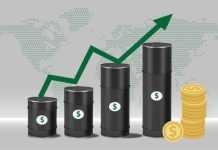Royal Dutch Shell could dethrone its biggest rival Exxon Mobil as the energy sector’s biggest cash generator after higher oil and gas prices combined with an improved performance lifted its 2017 revenue.
Chief Executive Ben van Beurden has made no secret of his desire to challenge the dominance of the world’s largest listed oil company after its $54 billion purchase of BG Group in 2016 catapulted Shell into second place in terms of production.
The Anglo-Dutch company on Thursday reported a more than doubling of profit in 2017 to $16 billion, the highest since the start of the 2014 downturn as the effect of years of costs cuts and the integration of BG Group filtered through.
“We enter 2018 with continued discipline and confidence, committed to the delivery of strong returns and cash,” van Beurden said in a statement.
Shell’s shares were 1.1 percent lower at 0842 GMT, compared with a slightly positive open for the FTSE 100 index.
Cash flow from operations in 2017 rose to $35.65 billion from $20.62 billion a year earlier, putting Shell on course to beat Exxon, which is forecast to have generated $32.6 billion in 2017, according to estimates by Jefferies analysts. Exxon reports earnings on Friday.
The rise was driven by a sharp recovery in oil prices in the second half of 2017, as the benchmark Brent price reached a three-year high of $70 a barrel.
But it was also due to a sector-wide drive to reduce costs to adapt to a world of “lower for longer” oil prices, as Shell and others cut thousands of jobs and lowered spending.
As a result Shell can now generate more cash than it did with oil prices above $100 a barrel and in November it raised its cash flow outlook from $25 billion to $30 billion by 2020, assuming an oil price of $60 a barrel.
Free cash flow — cash available to pay for dividends and share buybacks — rose to $27.6 billion from a negative $10.3 billion in 2016.
On a quarterly basis, however, Shell’s cash flow was down 21 percent at $7.25 billion, lower than expected, Biraj Borkhataria, analyst at RBC Capital Markets said in a note.
“Shell has had a good year overall and we don’t want to read too much into one set of numbers,” he said.
Shell in the fourth quarter scrapped its scrip dividend, in a sign that it is confident of being able to maintain around $15 billion in annual dividend payments without resorting to scrip or borrowing after a three-year oil price downturn.
Shell’s oil and gas production in the fourth quarter rose from the previous quarter to 3.756 million barrels of oil equivalent per day (boed) from 3.657 million boed, but on a yearly basis, it fell 4 percent as a result of asset sales.
Production was expected to come down by 270,000 boed in 2018 as a result of divestments, including the sale of a North Sea portfolio to Chrysaor and its stake in Woodside Petroleum.
Shell announced the sale of its stake in the Bongkot gas field and adjoining acreage offshore Thailand to PTT Exploration & Production PCL for $750 million on Wednesday and is on track to hit a $30 billion asset sale target.
Capital expenditure in 2017 was $24 billion, slightly lower than the $25-$30 billion range Shell set until 2020.
On a quarterly basis, Shell’s profit, based on a current cost of supplies (CCS) and excluding identified items, rose by 140 percent to $4.3 billion, slightly ahead of forecasts.
Shell said its gearing dropped to 24.8 percent from a peak of 29.2 percent in the third quarter of 2016 as it cut its debt to $74.65 billion. And while it took a $2 billion charge due to new U.S. tax rules, Shell expects a longer-term boost.












